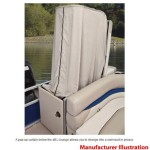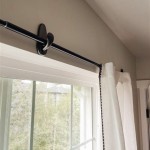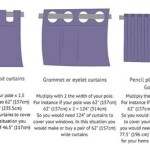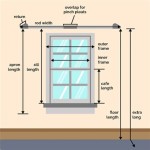Best Weights for Outdoor Curtains
Outdoor curtains offer a multitude of benefits, including privacy, shade from the sun, and protection from wind and insects. However, the open-air environment presents a significant challenge: keeping the curtains in place. Without adequate weights, outdoor curtains are prone to billowing, tangling, and potentially tearing, negating their intended purpose. Choosing the right weights is therefore crucial for ensuring that outdoor curtains function effectively and maintain their aesthetic appeal.
This article will explore various types of weights suitable for outdoor curtains, discussing their materials, advantages, disadvantages, and considerations for selecting the optimal option based on specific needs and preferences. Understanding these factors will enable individuals to make informed decisions, enhancing the performance and longevity of their outdoor curtains.
Key Considerations When Choosing Outdoor Curtain Weights
Several factors contribute to the effectiveness of outdoor curtain weights. Evaluating these aspects prior to purchasing is essential for ensuring optimal performance and preventing potential issues such as damage to the curtains or the surrounding structure.
Weight and Material:
The primary function of a curtain weight is to counteract the effects of wind. The weight required will depend on the size, material, and location of the curtains. Lighter fabrics require lighter weights, while heavier, more voluminous curtains will necessitate heavier options. The material of the weight is also important. Rust-resistant materials like stainless steel, coated iron, or specialized outdoor fabrics filled with sand or pebbles are ideal, especially in humid or coastal environments. Avoid materials prone to rust, as they can stain the curtains and degrade over time.Attachment Method:
Different weights utilize various attachment methods. Some are sewn directly into the hem of the curtain, while others clip or hook onto the fabric. Sewn-in weights offer a more permanent and discreet solution, while clip-on options provide greater flexibility and can be easily adjusted or removed. The chosen attachment method should be compatible with the curtain fabric and design, ensuring a secure and unobtrusive fit.Aesthetics:
While functionality is paramount, the appearance of the weights should also be considered. Weights that are visible should complement the style and color of the curtains. Discreet options, such as weights sewn into the hem, minimize visual impact. Consider the overall aesthetic of the outdoor space and select weights that blend seamlessly with the existing decor.Environmental Factors:
The prevailing weather conditions in the area significantly impact the required weight and material. Locations with frequent strong winds necessitate heavier weights and more secure attachment methods. In coastal areas, salt spray can accelerate corrosion, making rust-resistant materials a must. Consider the specific environmental challenges of the location when selecting curtain weights.Types of Outdoor Curtain Weights
The market offers a range of options designed to effectively weigh down outdoor curtains. Each type presents a unique set of advantages and disadvantages, making it crucial to understand their characteristics before making a final selection.
Metal Weights:
Metal weights are a popular choice due to their durability and effectiveness. They are typically made of stainless steel, coated iron, or lead (though lead is becoming less common due to environmental concerns). Stainless steel weights are highly resistant to rust and corrosion, making them suitable for various climates. Coated iron weights offer a more affordable alternative, but the coating must be well-maintained to prevent rust. Metal weights are available in various shapes and sizes, including discs, bars, and cubes. They can be sewn into the hem of the curtain or attached using clips or rings.The advantages of metal weights include their high density, ensuring a strong hold even in windy conditions. They are also relatively discreet, especially when sewn into the hem. The primary disadvantage is the potential for rust if the material is not properly treated. Metal weights can also be more expensive than other options.
Fabric Weights:
Fabric weights consist of small bags or pouches filled with sand, pebbles, or other dense materials. These weights are typically made of durable, weather-resistant fabrics such as canvas or outdoor-rated polyester. Fabric weights are often sewn into the hem of the curtain, providing a discreet and aesthetically pleasing solution. They are available in various colors and patterns, allowing for customization to match the curtain fabric.The advantages of fabric weights include their affordability and ease of use. They are also less likely to damage the curtain fabric compared to metal weights with sharp edges. The primary disadvantage is that they may not be as effective in extremely windy conditions as heavier metal options. Additionally, the fabric can degrade over time due to exposure to the elements, requiring replacement.
Chain Weights:
Chain weights consist of a continuous length of metal chain sewn into the hem of the curtain. This option provides consistent weight distribution along the entire bottom edge, preventing billowing and ensuring a smooth, even drape. Chain weights are typically made of stainless steel or coated metal to resist rust. They are a popular choice for heavier curtains and areas with frequent strong winds.The advantages of chain weights include their superior weight distribution and resistance to wind. They are also relatively discreet when sewn into the hem. The primary disadvantage is that they can be more difficult to install than other types of weights, requiring careful sewing to ensure proper placement and prevent the chain from shifting. Chain weights can also be more expensive than other options.
Clip-On Weights:
Clip-on weights offer a flexible and adjustable solution for weighing down outdoor curtains. These weights typically consist of metal or plastic clips with attached weights. They can be easily attached and removed from the curtain fabric without sewing, making them ideal for temporary or rental situations. Clip-on weights are available in various styles and sizes, including decorative options that add a touch of visual interest. They are often used in conjunction with other types of weights for added stability.The advantages of clip-on weights include their ease of use and adjustability. They are also a cost-effective option for adding weight to existing curtains. The primary disadvantage is that they may not be as secure as sewn-in weights, and they can be more visible. The clips can also damage delicate curtain fabrics if not used carefully.
DIY Weights:
For those seeking a more personalized and cost-effective solution, DIY weights offer a viable option. Various materials can be used to create custom weights, including pebbles, river stones, metal washers, or even water-filled pouches. These materials can be enclosed in fabric pouches or sewn directly into the hem of the curtain.The advantages of DIY weights include their affordability and customization options. They allow for the use of readily available materials and the creation of weights that perfectly match the curtain fabric and style. The primary disadvantage is that they require more effort and skill to create and may not be as durable or effective as commercially available options.
Installation and Maintenance of Outdoor Curtain Weights
Proper installation and maintenance are crucial for maximizing the effectiveness and longevity of outdoor curtain weights. Incorrect installation can lead to uneven weight distribution, damage to the curtains, or even safety hazards. Regular maintenance ensures that the weights remain in good condition and continue to function effectively.
Sewn-In Weights:
When installing sewn-in weights, it is essential to distribute them evenly along the bottom hem of the curtain. The number and weight of the weights will depend on the size and material of the curtain. Use a strong, durable thread and secure stitching to prevent the weights from coming loose. For chain weights, ensure that the chain is evenly distributed and securely sewn into the hem to prevent shifting.Clip-On Weights:
When using clip-on weights, distribute them evenly along the bottom edge of the curtain. Avoid placing too much weight on a single clip, as this can damage the fabric. Regularly inspect the clips to ensure that they are securely attached and not showing signs of wear or corrosion. Replace damaged or worn clips promptly.Maintenance:
Regular maintenance is essential for prolonging the life of outdoor curtain weights. Inspect the weights periodically for signs of rust, corrosion, or damage. Clean metal weights with a mild soap and water solution and dry them thoroughly. For fabric weights, check for tears or damage to the fabric and repair them promptly. If the filling material becomes damp, replace it with fresh, dry material.By following these installation and maintenance tips, individuals can ensure that their outdoor curtain weights function effectively and maintain their aesthetic appeal for years to come.

Weights For Outdoor Drapes Hometalk

Curtain Anchor Weights Sunbrella Spectrum Collection Outdoor Curtains

How To Secure Outdoor Curtains For Maximum Effectiveness Voila Voile

New 4 8 12 Sets Of Outdoor Curtain Windproof Weights Decorative Bags And Clips Weight Fixed On

New 4 8 12 Sets Of Outdoor Curtain Windproof Weights Decorative Bags And Clips Weight Fixed On

How To Keep Outdoor Curtains From Blowing In The Wind Proline Range Hoods

New 4 8 12 Sets Of Outdoor Curtain Windproof Weights Decorative Bags And Clips Weight Fixed On

Curtains Don T Drape Well Try These Easy Homemade Diy Curtain Weights

Curtains Don T Drape Well Try These Easy Homemade Diy Curtain Weights Robin Kramer Writes

10 Ways To Weigh Down Outdoor Curtains A Comprehensive Guide








